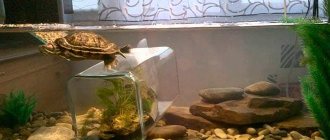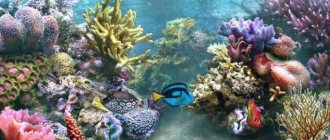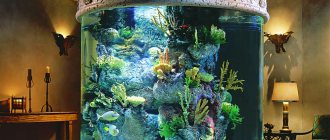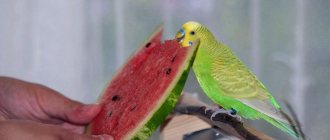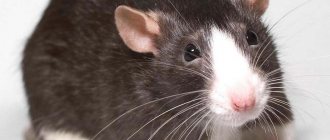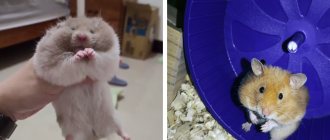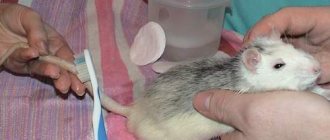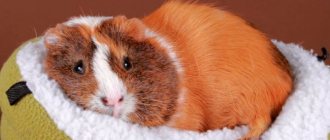Turtles belong to the order of reptiles. There are at least 328 species. All of them are divided into marine and terrestrial, the latter can be land and freshwater.
The variety of turtle species is amazing. The largest can grow up to 2.5 m in length and weigh more than 900 kg. Once upon a time, larger individuals lived in Africa, Australia and America, but they became extinct after the appearance of humans.
Scientists, studying the preserved skeletons, came to the conclusion that the Archelon sea turtle reached 4.5 m in length and weighed up to 2.2 tons. There are not only such giants, but also smaller species, they can fit in the palm of a person.
The smallest turtles in the world weigh only 124 g and do not grow more than 9.7 cm. You will learn more about them and other small species from our article and see their photos.
Keeping small turtles
Regardless of whether the turtles are small or not, everyone needs care, and it is important to know which one is suitable for them and which is not.
When buying an aquarium for your future pet, you need to know that the water in it should be filled to a level of at least twenty centimeters. This height has long been calculated, since the peculiarity of these reptiles was noticed to walk at the bottom of the aquarium. For those who don't know, turtles don't have gills like fish, so they can't breathe underwater. It follows from this that, after walking along the bottom of its house, the turtle emerges to take a sip of oxygen. If there is more than twenty centimeters on the surface of the water, then it may simply not have time to do this, and will die from lack of oxygen. It is best to buy an aquarium with a larger area rather than a tall and narrow one. In the natural environment, turtles live in conditions where moisture and land are combined, and if the aquarium area is large, it can be equipped with both a dry zone and a sea zone.
As for nutrition, small turtles eat little; as food they prefer plants that grow in water; they can eat small fish and shellfish. If you want to feed your pet more sophisticated food, then special mixtures are sold that contain fish, shrimp and shellfish. In addition, you can please your little friend with pieces of beef that the turtle will like. As for greens, you can also supplement your pet’s standard diet with new dishes, give him lettuce leaves, or something green that will enrich the diet and benefit the reptile.
In addition to the above-mentioned species of turtles, there are also the following: red-eared, swamp, long-necked, and mud turtles. Silt is considered the most comfortable to keep, because it is the most unpretentious of all. This type of turtle spends most of its life in the aquatic environment; very rarely there come those moments when the turtle crawls onto land. This type of species requires a slightly smaller aquarium than other species. Fifty or seventy liters of housing will be enough for them. If you put soil on the bottom and plant some plants intended for growing in an aquarium, then these will be virtually ideal conditions for the mud turtle. If you do not have the time or opportunity to plant greenery, then place some object at the bottom in which the turtle can easily hide. This recommendation is already necessary. In case of any danger, the reptile must have a place where it can hide, otherwise it will not be comfortable for it to live with you.
It is worth paying close attention to the type of water your turtle swims in. The first condition is cleanliness, the water needs to be settled, or you need to choose special, purified water
The second important condition is the temperature of the water in which the turtle is located. The most comfortable range for her will be from twenty-two to twenty-five degrees
Each species has its own conditions under which they feel most comfortable living next to a person. If for undemanding reptiles just an aquarium and water in it is enough, then for more demanding species you also need a certain light, room temperature level, certain food products, regime and diet, which must be strictly maintained
There are species for which it is important that the room has clean air with a certain humidity
Each owner chooses a pet for himself and his capabilities. Some people enjoy working with a reptile, satisfying all its needs, but there are people who need to feed their pet once a week, and that should be enough. There are as many people as there are animals.
What to look for when purchasing
If you can identify a healthy puppy, kitten or even a parrot with the naked eye, then with reptiles everything is a little more complicated. The criteria are similar: the animal must be active, eat well and show curiosity.
You should make sure that he has a clean and smooth shell without damage or plaque, clear eyes without signs of infection or pus, and good reflexes.
Active swimming is also a sign of a healthy individual. It is better to take turtles from a trusted nursery or pet store.
If you add fish to the aquarium with them, it is recommended to add larger ones so that they are not perceived by the turtles as potential food.
Cape speckled
The smallest turtle in the world is usually considered to be the Cape speckled turtle. The carapace, or upper part of the shell, of its representatives reaches 6-10 centimeters in length. Such individuals weigh only 90-160 grams.
They are endemic to South Africa and live exclusively in Namibia and the Northern Cape Province of South Africa. Their shell is brown with black and yellow spots. The central part of the carapace scutes is usually depressed, and there are small spurs on the limbs of the animal. The smallest turtles live in semi-deserts and savannas, in woodlands and bushes. Unlike predatory muskellunges, they feed exclusively on plant foods and the excrement of other animals.
Hawksbill feeding
Hawksbills are omnivores, but prefer to feed on sea sponges. These multicellular animals contain toxic chemical compounds that accumulate in the turtles' tissues. Consumption of the meat of such turtles by humans can cause serious illness and even death. Turtles E. imbricata are important members of reef communities, saving corals from being overwhelmed by sponges. It is believed that one turtle can eat about 500 kg of sponge per year.
At the aquarium, hawksbills prefer octopuses for lunch
Sea turtles also feed on mollusks, crustaceans, fish, and algae
Unfortunately, turtles on coral reefs often mistake plastic debris for food, which makes their digestion difficult and leads to death.
You have to be careful when feeding turtles - they can bite off your finger
The narrow, sharp beak of hawksbills is an excellent tool for searching and capturing food among coral crevices. Here, on ledges and in reef shelters, turtles rest during the day and night.
Unlike green sea turtles, which often migrate several hundred miles between feeding and nesting grounds, E. imbricata feed year-round on the reefs opposite their nesting grounds. In aquariums, all species of sea turtles can be kept on high-calorie protein diets.
Fringed turtle (40 cm)
The fringed turtle grows up to 15 kg and is the eighth largest turtle on the planet. The flattened shell grows up to 40 cm in length. These turtles have many distinctive features: a snake-like neck and flat paws overgrown with fringed leathery processes, a flat triangular head, small but keen eyes, small mustaches, a grin from ear to ear, sharp claws.
Matamata, as the people of South America call the turtle, looks like an oblate dragon. She hunts at night. Thanks to its amazing camouflage, the predator is not immediately visible in muddy water. The unwary fish quickly falls into the wide mouth and immediately ends up in the stomach - toothless matamatas. With a lightning-fast throw it can catch a small bird. The reptile prefers shallow river waters with stagnant water. In case of danger, it quickly buries itself in the mud. It spends winter hibernation in it.
9. Far Eastern
A freshwater turtle that is especially common in Asia. In some countries they eat it, so it is bred on farms. The length of the carapace of the Far Eastern tortoise is no more than 20-25 cm, but occasionally there are individuals in which it grows up to 40 cm, with a maximum weight of 4.5 kg.
She has a round shell covered with soft greenish-gray skin, with small yellow spots visible on it. The limbs and head are also gray, slightly greenish.
It can be found in Japan, China, Vietnam, and in our country - in the Far East. The Far Eastern turtle chooses fresh water bodies, lakes or rivers for life, and can live in rice fields. During the day it likes to bask on the shore, but in extreme heat it hides in damp sand or water. If frightened, it will bury itself in the bottom silt.
Spends a lot of time in the water, swimming and diving. If you catch a turtle in the wild, it will behave aggressively, bite, and its bites are very painful.
Vulture
The snapping (alligator) turtle lives in fresh water bodies in America. Most often found in Mississippi and Illinois rivers. It differs from its fellows in its aggressive behavior. If you catch a snapping turtle, whose length reaches 1.5 meters and weighs 60 kg, it will fiercely resist, try to bite the enemy with powerful jaws and release a hissing stream of liquid from the anal glands. These animals are predators and feed mainly on fish. The alligator turtle lowers its head into the pond, sticks out the thin tip of its tongue, reminiscent of a worm, and waits for the fish to grab onto it. Afterwards, she catches the prey with her teeth and chews it.
Interesting! The shells of all aquatic turtles eventually become covered with algae, which become food for fish.
Behavior
The Cape speckled tortoise lives in areas with rocky ground, where it can easily hide under stones or in narrow crevices when predators appear. There she hides during drought from extremely high temperatures. Its small size allows it to easily find suitable shelters.
The camouflage color helps to be invisible and blend into the landscape.
The reptile is active in the morning and evening hours. In rainy or cloudy weather it is active at noon. The diet consists of food of plant origin. It is based on perennial herbs from the Oxalidaceae family and various succulents, primarily Crassula.
Land species
Land turtles belong to the family Testudinidae, which includes 16 genera and 57 species. Among them there are both small, just over 10 cm in length, and giant animals. But large species live only on the Galapagos and Seychelles islands.
Elephant turtle
Photo: tourvipclub.ru
The species Chelonoidis elephantopus is also called the Galapagos tortoise, due to its area of distribution. It feeds on plants, including those that are poisonous to other animals.
These are huge reptiles, the size of their shell reaches 122 cm, and their body weight reaches 300 kg. According to some reports, there were individuals up to 180 cm long and weighing more than 400 kg.
The shape of the carapace differs among different populations. In reptiles that live on islands with humid highlands, it has a dome shape, while in those that live in dry lowlands, the carapace is flatter. Its color is light brown, with a characteristic pattern of plates.
Giant, Seychelles (Aldabrachelys gigantea)
Photo: goodfon.ru
The giant reptile lives on the Seychelles and Mascarene Islands, choosing plains, bushes or marshy areas. Previously distributed in Madagascar.
Its shell is bony, quite dense, and has a neck shield. It is by this feature that the reptile can be easily distinguished from an elephant turtle. The length of the carapace in adult individuals ranges from 105 to 120 cm, and body weight reaches 120 kg.
Giants feed mostly on plant foods - roots, vegetables, fruits, grass and dry leaves.
Leopard tortoise
Photo: wallpaperscraft.com
The panther or leopard tortoise (Stigmochelys pardalis) is distributed throughout Africa. It chooses savannah and dry highlands for living, but can also live at an altitude of up to 2 km above sea level. It is the second largest among its relatives living on this continent. The length of the shell is up to 70 cm, body weight is up to 50 kg.
This is a beautiful reptile with a leopard-print carapace - sandy yellow, decorated with a black and brown pattern. With age it becomes less bright.
Individuals feed on plant foods, fruits and herbs, but if there is a lack of them, they can switch to animals.
Radiated turtle (Astrochelys radiata)
Photo: wallbox.ru
This is a very rare species, found only in the south and southwest of Madagascar. For living it chooses xerophytic forests with cactus-like shrubs and grasses. It feeds mainly on vegetation, but when the opportunity presents itself, it also eats animal food.
The reptile attracts attention with the beauty of its shell. He is tall, black and brown, with a yellow pattern in the form of converging rays
In adult individuals, the carapace length is from 24 to 39 cm, and the body weight reaches 13 kg.
Elastic turtle (Malacochersus tornieri)
Photo: reptilefact.com
In another way, this turtle is called flat-shelled. Her carapace is really flat, and also soft, consisting of thin plates. It is capable of contracting so that from the abdominal side you can see how the animal’s body contracts during breathing movements.
The color of the shell is golden, with brown stripes, length - from 15 to 18 cm. Females weigh a little more, up to 550 g, and males - approximately 360 g.
Elastic turtles are found in southern Kenya and northeastern Tanzania. They live in the mountains and foothills and are excellent at climbing steep rocks. They are capable of getting into even narrow cracks, thereby justifying their name.
They feed mostly on vegetation and can eat dry grass. Water is consumed in small quantities.
Mexican gopher (Gopherus flavomarginatus)
Photo: cantoo.org.au
This species is native to Mexico. Inhabits grassy hills, lives in the mountains, rising to 1-1.4 km above sea level. The species is endangered and is listed in the Red Book. Many populations no longer exist, while others are on the verge of extinction.
The Mexican gopher has a tall, slightly flattened shell, shaped like a dome. It is colored brownish-yellow. With its front paws and powerful claws, the animal can dig the ground if necessary. The size of the carapace of an adult reptile reaches 40 cm, weight – 14 kg. The gopher feeds on plants, the basis of its diet being the cereal grass Hilaria mutica.
This article does not list all types of turtles - there are hundreds of them. Unfortunately, many of them are endangered, and these unique animals can only be seen in a few corners of the planet.
Spreading
The smallest turtle is found only in South Africa and southern Namibia. Its habitat is located in Namaqualand, an arid region on the Atlantic coast of both countries. For this reason, it is often also called the Namaqualand tortoise.
It is most often observed in the Ai-Ais-Richtersveld transboundary park in the Northern Cape province in the north-west of South Africa at altitudes up to 1000 m above sea level.
To date, subspecies are unknown, but it is customary to distinguish the northern (Hs signatus) and southern morph (Hs cafer). The first of them is characterized by the presence of a beige or brownish color with large dark spots and deep grooves between the scutes. It is distributed on the semi-desert plateaus south of the Great Escarpment and the Orange River valley.
- Red-eared turtle at home
The southern morph is slightly larger than the northern one, has a reddish main color and a smoother shell with jagged edges. She lives among the sandstones in the Province of the Cape of Good Hope, located between the cities of Piketberh and Claver in the valley of the Ulifants River.
Great red-eared turtle
This is also a type of freshwater turtle. It is widespread in Mexico and America. A distinctive feature of females is that they are larger than males, and their shell length is 37 cm, while that of males is 20 cm. The turtle has red spots on the side of its head, hence its name. The animal's habitat is dirty and swampy ponds.
The lifestyle of this turtle is sedentary. However, if there is danger, she reacts quite quickly and hides. The red-eared slider can easily adapt to life in captivity and, with proper care, can live up to 50 years. To maintain it, you need an aquarium with a volume of 200 liters.
Atlantic Ridley
This species is considered the smallest among sea turtles, as well as the fastest growing. An adult turtle can grow up to 77 cm and weigh up to 45 kg. They have a gray and green carapace, shaped like a heart, but the young are usually gray-black. Females are larger than males.
The Atlantic ridley has chosen the Gulf of Mexico and Florida as its habitat. Prefers shallow water. They feed on small marine animals, but if necessary they will easily switch to plants and algae.
Mating season
Reproduction in reptiles occurs at different times. It depends on the location and type of animal. But all members of the class have similar traits. For the right to fertilize a female, males enter into battle with each other. Land turtles try to turn over or force their opponent to retreat by striking them with their shells. After the competitor leaves the battlefield, the winning male begins courtship. At the same time, he tries to ensure that the female takes the best position for mating.
To attract a mate, the male strokes her face with his limbs or sings.
Females dig holes in the sand to lay eggs. They also often use crocodile nests or their own burrows. The masonry is securely covered with soil from above, and then compacted with light blows of the shell.
The surface of the eggs is covered with a leathery membrane or shell. There are up to 190 of them in the clutch. The incubation period is 91 days. The female lays several clutches during the mating season.
Turtles are solitary reptiles. They look for a mate only during the mating period.
Miolania
Myolania are extinct creatures from a genus of secretive-necked turtles. They inhabited the territory of Australia and New Caledonia 2 thousand years ago. Upon careful study of the remains of Myolania, found in the 19th century by paleontologists from America, it was found that the length of the turtle from the tip of the muzzle to the tail was about 4.5 meters. On her head were two massive horns, with which she defended herself from natural enemies and dug the ground in search of food. The animal's tail was also studded with bone spines that could pierce the thick skin of the ankylosaur. According to the pattern of discovering the remains of ancient turtles, they lived in dense forest thickets, next to rivers and lakes. Their diet included only plant foods.
How to keep it in an apartment
The basis of the diet of those turtles that live in an apartment is juicy leaves of vegetables and flowers (dandelion), apples, cucumbers, beets and tomatoes.
To compensate for the lack of protein structures, you need to feed the animal with boiled bird eggs, and if necessary, include supplements and vitamins in the daily menu.
When keeping aquatic species, the menu includes dried daphnia, bloodworms, earthworms, aquarium fish, small insects, and algae.
The turtle's lifestyle requires moderation in diet. Young individuals need to be fed in the morning and evening, and adults - once a day, no more often. Unloading should be done weekly.
Land giant
The absolute record holder among the species existing today is the Galapagos tortoise, also called the elephant tortoise. The dimensions of this largest turtle are impressive - body weight is 400 kilograms with a length of 2 meters. In total, there are currently about 11 subspecies, although there used to be more.
Characteristics:
- long legs and elongated neck;
- can live for a long time without food;
- the preferred treat is plants;
- drinks a lot of water;
- lays eggs all year;
- Life expectancy is on average 100 years (there were also centenarians who lived about 300 years).
The Galapagos elephant tortoise lives in the Galapagos Islands. Their peculiarity is that they even feed on plants considered poisonous.
It should be noted that about three decades ago this species of turtle was on the verge of extinction, since their meat was a favorite delicacy of sailors from many countries. However, thanks to the efforts of scientists, some subspecies were saved. Today the number of individuals is about 20 thousand.
The smallest turtle is Homopus signatus (Cape speckled flathead)
Photo: gkaim.com
The Cape speckled flatback turtle (Homopus signatus) is a terrestrial species. She is the smallest in the world. The length of the carapace, painted light beige with black splashes, is only 9 cm in females and 11 cm in males. The weight of a newborn reptile is only 5-8 grams, and in adults it ranges from 95 to 165 g.
Their modest size allows the reptiles to deftly hide in rock crevices and become almost invisible against their background. They can be found in South Africa, namely in the semi-arid regions of the Northern and Western Cape. It extends from the Orange River in the north to Pikberg in the south, from the Atlantic coast in the west to Calvinia in the east.
By 1996, Homopus signatus was on the verge of extinction and was listed as vulnerable on the South African Red List.
Craseonycteris thonglongyai (bat)
Body length and weight of an adult: 3 cm, 1.7 g.
Craseonycteris thonglongyai (also known as "pig" and "bumblebee") is not only the smallest animal in the world, but also the smallest representative of the class of mammals.
The mouse got its name because of its muzzle - it is flat and fleshy, reminiscent of a pig, and is located between very small eyes. Some members of the class seem like real giants compared to her.
Distinctive features of such an unusual bat include wide and long wings, loss of a tail and an unusual muzzle. The color of the mouse on the back is reddish-brown, and lighter towards the bottom. This baby's diet includes insects.
Features of character and lifestyle
Photo: Leatherback turtle
Sea turtles have a calm nature. They are leisurely, although they are capable of swimming quite quickly and well. Sea turtles spend their entire life in water. Turtles stay in shallow water near the shores, however, when hunting they can dive deep into the water and stay there for a long time.
All sea turtles make long migrations in order to have offspring. No matter how far turtles are from the warm tropical shores where they were once born, when the time comes, they return there to lay eggs. In this case, one turtle always forms a clutch in the same place. Turtles breed at the same time and on the shores during the breeding season you can see hundreds of females laying eggs.
The social environment of sea turtles is undeveloped. Turtles most often live alone. Young turtles, hiding from predators, spend almost all their time in algae thickets, where they can feel safe. Older turtles swim freely in the water. Sometimes sea turtles like to bask in the sun by climbing on rocks.
Under poor environmental conditions and lack of food, sea turtles are capable of falling into a kind of suspended animation. At this time, turtles become lethargic and eat little. This helps turtles survive during winter. In winter, turtles sink to the bottom and can live anaerobically for a long time without swimming to the surface.
musky
It belongs to the species of mud turtles. She has an oval carapace with 3 longitudinal wavy ridges. the musk turtle because it has special glands. In moments of danger, it begins to emit an unpleasant odor.
Americans often call them stinkers, and try to handle them carefully, because... This scent is persistent and can last for several hours when absorbed into clothing. They are found naturally in North America, in freshwater bodies of water with slow currents. They grow up to 10-15 cm.
In winter they hibernate, in summer they like to bask in the sun, climbing on snags and trees that have fallen into the water. They hunt at dusk or at night.
Elephant
The elephant or Galapagos tortoise is an endemic species that inhabits the territory of the Galapagos Islands. It is recognized as the largest land turtle and ranks 10th in weight among modern reptiles. The animal’s body weight (with shell) is over 400 kg, and its length is over 1,800 centimeters. In addition to its gigantic size, the Galapagos tortoise is known for its longevity. In zoos, individuals live 170-180 years, and in the wild they die at the age of 210 years, making them the longest-living vertebrates on Earth. A special feature of elephant turtles is that dozens of species of moss and fungi reproduce on their shells. They give it a special pattern that remains even after the removal of parasitic plants.
Interesting! The elephant tortoise's shell can support 200 times the animal's body weight.
3. Tuberous
Its other name is terrapin . This is a species of freshwater turtle that lives in the salt marshes of the United States, in the coastal area. The lump turtle is gray, but can also have brown, white or yellow skin, covered with a gray or brown shell. Its diameter is 19 cm in the female and 13 cm in the male, but larger specimens are also occasionally found.
Body length is from 18 to 22 cm in females, and 13-14 cm in males. They weigh about 250-350 g. These turtles eat crabs, shellfish, small fish, and occasionally indulge in marsh vegetation.
They themselves suffer from attacks by raccoons, skunks and even crows. Local residents also love their meat, so this species is bred on farms. They were once the main food of European settlers, and in the 19th century they became a delicacy. In nature they can live up to 40 years.
Freshwater species
The freshwater family Emydidae is very large and includes 25 genera and 77 species. As a rule, these reptiles are medium or small in size, have an oval streamlined shell and developed limbs with sharp claws. Many of them are distinguished by bright, beautiful colors.
snapping turtle
Photo: blikkruzs.blikk.hu
The snapping turtle (Chelydra serpentina) is a representative of the genus Chelydra. It received its second name for its violent temper - when trying to catch it, a person risks encountering aggression - the reptile will actively defend itself and bite.
These animals can be found in the east and central regions of the United States, and in the southeastern part of Canada. These are large individuals with a body length of up to 35 cm and a weight of up to 14 kg. Some reptiles of this species can reach 30 kg.
They live in various bodies of water, mainly with muddy bottoms. They feed on fish, small aquatic life, and waterfowl. They do not disdain carrion, but at the same time they are excellent hunters - they have powerful clawed paws and developed jaws, which allows them to grab and tenaciously hold their prey.
Vulture (Macrochelys temminckii)
Photo: pinterest.ru
The snapping or alligator turtle belongs to the subfamily Chelydrinae. It is considered the largest of its freshwater counterparts. The length of its carapace is 66-80 cm, and its weight is 60-91 kg. The maximum body weight of the representatives of this species was reached by an individual that weighed 113 kg.
This is a reptile with a dark brown shell, decorated with 3 large longitudinal ridges. She has a large head, a muscular neck and a long tail, massive paws with membranes between the toes.
Macrochelys temminckii lives in the southeastern United States. Prefers muddy ponds with abundant vegetation. It feeds mostly on fish, but can eat worms, crustaceans, snails and snakes. Hunts waterfowl and its small relatives, sometimes eats plants.
Far Eastern turtle (Pelodiscus sinensis)
Photo: inaturalist.nz
The second name of the species is Chinese trionix. This is a representative of the genus of three-clawed turtles, lives mainly in Asian countries. In some of them, these reptiles are bred on an industrial scale for further consumption. In Russia they can only be found in the Amur and Khanka regions.
Trionix has a round shell without horny scutes, covered with soft skin. It is gray-green in color and has yellow spots. The head, paws and neck are gray or brown, with a green tint. The body length of the reptile is 20-25, sometimes up to 40 cm. Weight is a little more than 4 kg.
Greater soft-bodied Cantor (Pelochelys cantorii)
Photo: typicoh.pw
This species also belongs to the three-clawed species. Reptiles have a smooth shell with tubercles at the top. Moreover, in young individuals there are no protrusions; they appear only in adult animals. The length of the carapace reaches 2 m, body weight – 50 kg. These are one of the largest freshwater turtles.
Representatives of the species are found in Burma, Thailand, India, Malaysia, Indonesia, Southern China, Vietnam, Cambodia and the Philippines. They prefer to settle in bodies of water far from the sea and feed on both plant and animal foods.
Pond slider
Photo: yandex.kz
The red-eared or yellow-bellied turtle is widespread. She lives in the USA, Mexico, Central and South America, South Africa, Japan, Vietnam, Thailand, Malaysia and Singapore. Settles in shallow reservoirs with low muddy banks. In Russia it cannot be found in natural conditions, but it is very popular among aquarists.
The reptile's shell is olive, with a yellow pattern. The abdomen is yellowish in color, and on the head, next to the eyes, there are elongated red spots - this is why the reptile got its name.
The individual grows up to 7-10 years. At the age of up to one year, the size of the carapace varies from 2.5 to 3 cm, and weight - from 1.2 to 4 g. But when growth stops, these figures are 17-20 cm and 0.7-1.2 kg, respectively.
European marsh
Its full name is European marsh turtle , and is a freshwater turtle. The length of its carapace is about 12-35 cm, maximum weight is 1.5 kg. Adult turtles have a dark olive or brown carapace, some are almost black, covered with small yellow spots.
The skin of the turtle itself is dark, but there are many yellow spots on it. The eyes have orange, yellow or reddish irises. As the name implies, it can be found in Europe, as well as in Central Asia and the Caucasus, etc.
The European turtle chooses swamps, lakes, and ponds to live, avoiding fast-flowing rivers. She is a good swimmer and diver and can stay underwater for a long time, but she usually comes to the surface every 20 minutes.
If it notices danger, it hides in the water or buries itself in mud, and can run under stones. It is active during the day and loves to bask in the sun. Overwinters at the bottom of reservoirs, buried in silt.
Population and species status
Photo: Land turtle in nature
Only 228 species of turtles have protected status from the International Union for Conservation of Nature, and 135 of them are on the verge of extinction. The most famous rare endangered species of land turtles is the Central Asian land turtle.
The main reasons that threaten the growth of the population of land turtles:
- poaching;
- agricultural activities;
- construction activities.
In addition, land turtles are very popular pets, which also does not work in their favor. After all, for this purpose, turtles are constantly caught and kept in captivity until sold, and not always in good conditions.
Turtle meat is a valuable delicacy, which is why it is popular among restaurateurs. The unpretentiousness of turtles greatly facilitates their transportation, which is why they are transported as “live canned food.” Animal shells are often used in the manufacture of various souvenirs and traditional women's hair jewelry.
Painted
Its other name is decorated turtle . It received this name because of its attractive colors. The painted turtle is the most common species in North America, where they can be found in freshwater bodies.
The length of an adult female is from 10 to 25 cm, males are slightly smaller. She has black or olive skin and has orange, yellow and red stripes on her limbs. There are several subspecies of the painted turtle. In the early 1990s, this species was the second most popular turtle kept in the home.
Their numbers could be reduced, because... Their habitat is being destroyed, many die on highways, but due to the fact that turtles easily get along with people, it has helped them maintain their numbers.
They feed on insects, fish, and crustaceans. Thanks to their strong shell, they have almost no enemies, except raccoons and alligators. But the eggs of these turtles are often eaten by snakes, rodents and dogs. In winter, painted turtles sleep by burying themselves in the mud at the bottom of reservoirs.
The largest turtle in the world is Dermochelys coriacea (leatherback)
Photo: yaplakal.com
The leatherback turtle (lut) is the largest in the world. Today this species is the only one in the family Dermochelyidae. Huge reptiles are unique not only for their size. They have many differences from other turtles due to the fact that their evolution has followed a separate path since the Triassic.
The loot's shell does not consist of horny scutes, like its counterparts, but of small bony plates. The pseudocarapace is covered with rough, thick skin (which is how the species got its name) and has longitudinal ridges.
These giant animals can be found in tropical seas, but sometimes they swim to temperate and northern latitudes. They feed on fish, shellfish, crustaceans and jellyfish, even poisonous ones. They can also eat algae.
The weight of the largest of the captured individuals was 916 kg, body length - 2.6 m, and flipper span - 2.5 m. According to other sources, the measurements are as follows: 600 kg, 2.5 m and 5 m, respectively.
Arrau (Podocnemis expansa)
Body length: up to 110 centimeters
Tartaruga, as this turtle is also called, belongs to the family of giant side-necked turtles. These turtles mainly live in South America, on the warm coasts of the Pacific and partially Atlantic oceans.
A large turtle, reaching sizes from 80 cm to 1.10 meters and weighing 70 kg, inhabited the shores in ancient times. Relatively large head on a thin neck. There are two projections at the bottom of the head, and a longitudinal groove between the eyes. The shell is without protrusions, ovoid in shape.
Since ancient times, the Indian tribes of the Amazon have used Arrau eggs to obtain oil, and also ate boiled and fried eggs. Over time, turtle meat began to be supplied to the USA and other countries.
Europeans discovered this species of turtle to science and the world in 1812. Note that with such an impressive size, all Arrau turtles eat only plants.
Turtle sizes
Turtles are one of the orders of reptiles, whose representatives appeared more than 220 million years ago. Slow and clumsy, they nevertheless cope well with survival in the wild. All this is thanks to the durable shell that covers their body, capable of withstanding loads 200 times the body weight of its owner.
Turtles have mastered both aquatic and terrestrial space, spreading in all climatic zones from temperate to tropical zones. Inhabitants of land and seas are usually larger than species that inhabit ponds, swamps and other fresh water bodies. Leatherback sea turtles, or lutas, are reaching record sizes in the world. Their body length can reach up to 2.5 meters, and their weight can reach up to 900 kilograms. The elephant or Galapagos species is also quite large. Its representatives live on land and reach 1.2-1.8 meters in length, while they weigh about 300 kilograms.
The smallest turtles typically include Cape turtles, snapback turtles, and musk turtles. Their dimensions rarely exceed the length of two matchboxes, and their weight ranges from 100 to 300 grams. The smallest turtles for home are very comfortable animals. They don’t require much space, which means you don’t have to build bulky enclosures or aquariums that take up half the living space. That is why they are often kept as pets.
Reproduction
The world's smallest turtles reach sexual maturity when they reach about 70% of their maximum body length. In the wild, due to a constant lack of food and environmental conditions, reptiles usually become sexually mature at 10-12 years, and in captivity, with good care and plentiful feeding, twice as fast.
The fertilized female lays eggs in late winter or early spring. She finds a place protected from the sun, usually in the shade of plants, and digs a small hole in it about 4 cm deep.
There is only one relatively large egg in a clutch, 8-11% of the female’s body length. It has a fairly hard shell, which prevents moisture from evaporating from it.
During the season, she makes several such clutches in different places, which increases the likelihood of turtles appearing in a dry climate. The number of clutches depends on precipitation, which falls irregularly every year. Incubation lasts from 101 to 145 days.
The hatched turtles are completely ready for independent existence. Immediately after their birth, they rush in search of a reliable shelter.
Turtles belong to the order of reptiles. There are at least 328 species. All of them are divided into marine and terrestrial, the latter can be land and freshwater.
The variety of turtle species is amazing. The largest can grow up to 2.5 m in length and weigh more than 900 kg. Once upon a time, larger individuals lived in Africa, Australia and America, but they became extinct after the appearance of humans.
- What do sea turtles eat? Giant sea turtles
Scientists, studying the preserved skeletons, came to the conclusion that the Archelon sea turtle reached 4.5 m in length and weighed up to 2.2 tons. There are not only such giants, but also smaller species, they can fit in the palm of a person.
The smallest turtles in the world weigh only 124 g and do not grow more than 9.7 cm. You will learn more about them and other small species from our article and see their photos.
Spurred turtle (75 cm)
The seventh place in the top of the largest scoops in the world belongs to the spurred tortoise from Africa. By the age of 20, males gain up to 100 kg of weight, their shell grows up to a meter in length. This species has a good disposition. The turtles are very beautiful, they look like wax sculptures. They take root well in captivity, but large individuals die. Claws and spurs on the hips grow in reptiles by the age of 3. Turtles begin to scratch walls, floors, and end up in zoo terrariums.
In nature, desert inhabitants can go for a long time without water, they feed mainly on plant foods, but they can diversify their menu with protein: insects, carrion. In case of danger, the paws and tail are hidden completely, but the head does not enter the “house”. Land giants are mercilessly exterminated for the sake of beautiful shells, durable skin, and tasty meat.
6. Central Asian
Its other name is steppe tortoise , which belongs to the land family. She is now one of the most popular pets and can live from 10 to 30 years and even longer.
Sexual maturity occurs at 10 years for females and at 5-6 years for males. As the name suggests, it is found in Central Asia. She prefers clay and sandy deserts. It can grow up to 15-25 cm, males are slightly smaller. But most often their size is 12-18 cm.
In nature, the Central Asian tortoise eats melons, shoots of perennial grasses, berries, fruits, and desert plants. In captivity they are also given plant food.
Leathery
The largest turtle in the world, listed in the Guinness Book of Records. Its length is over 200 cm, and its weight exceeds 550 kilograms. The creature's head is very large and does not retract under the shell, so it is considered a vulnerable spot. The span of the front flippers is up to 550 cm. The dorsal shield of a turtle is a hard but flexible growth with five longitudinal ribs. Young animals have white spots on it, which disappear with age.
This species of turtle is becoming rarer every year. Scientists predict that in a couple of decades it will receive the status of “endangered”. But for now you can see leatherback turtles on the coast of North America, in the waters near Madagascar, Arabia and in the Black Sea. Occasionally they swim to Bermuda and Europe.
Bighead
A freshwater turtle whose shell length does not exceed 20 cm. It is called “ big-headed ” because of the size of the head, which is disproportionately large. Due to its size, it does not retract into the shell.
She has a movable neck and a very long tail. It is common in Vietnam, China, Thailand, etc., and chooses clear and fast streams and rivers with a rocky bottom to live.

